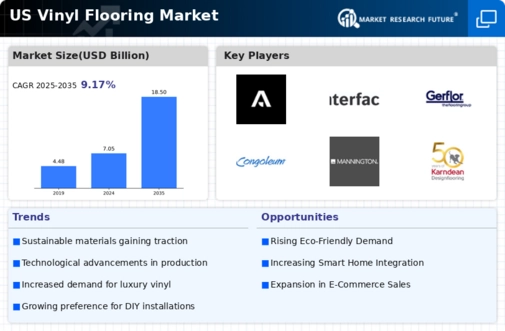Expansion of Distribution Channels
The vinyl flooring market is experiencing a significant expansion of distribution channels, which is facilitating greater accessibility for consumers. Retailers are increasingly offering vinyl flooring through various platforms, including online marketplaces and home improvement stores. This trend is particularly beneficial for consumers who prefer the convenience of shopping from home. Additionally, partnerships between manufacturers and distributors are enhancing the availability of diverse product lines, catering to a wider audience. As the market continues to evolve, the expansion of distribution channels is likely to play a crucial role in driving sales and increasing market penetration, ultimately benefiting the vinyl flooring market as it adapts to changing consumer shopping behaviors.
Increased Focus on Home Renovations
The vinyl flooring market is benefiting from a surge in home renovation activities across the United States. As homeowners invest in upgrading their living spaces, vinyl flooring is often chosen for its versatility and aesthetic appeal. According to recent data, approximately 60% of homeowners are planning renovations, with flooring being a primary focus. This trend is driven by the desire to enhance property value and create more functional living environments. Vinyl flooring, with its wide range of designs and finishes, allows homeowners to achieve their desired look while remaining within budget. As renovation projects continue to rise, the vinyl flooring market is poised for growth, catering to the evolving preferences of consumers seeking modern and stylish flooring solutions.
Technological Innovations in Manufacturing
The vinyl flooring market is witnessing a transformation due to technological innovations in manufacturing processes. Advances in production techniques have led to the development of high-quality vinyl products that mimic the appearance of natural materials while offering enhanced durability. Innovations such as digital printing and improved wear layers have elevated the aesthetic appeal and performance of vinyl flooring. As a result, the market is seeing an influx of products that cater to diverse consumer preferences, from luxury vinyl tiles to waterproof options. This technological evolution not only enhances product offerings but also contributes to the overall growth of the vinyl flooring market, as consumers are increasingly drawn to innovative solutions that combine style and functionality.
Rising Demand for Affordable Flooring Solutions
The vinyl flooring market is experiencing an increase in demand for cost-effective flooring options. As consumers seek budget-friendly alternatives to traditional materials like hardwood and ceramic tiles, vinyl flooring emerges as a viable solution. The affordability of vinyl products, often priced at $2 to $5 per square foot, makes them attractive to homeowners and commercial property managers alike. This trend is particularly pronounced in the residential sector, where renovations and new constructions are on the rise. The market's growth is further supported by the increasing number of DIY enthusiasts who appreciate the ease of installation associated with vinyl flooring. Consequently, the vinyl flooring market is likely to see sustained growth as more consumers prioritize affordability without compromising on style and durability.
Growing Awareness of Health and Safety Standards
The vinyl flooring market is increasingly influenced by heightened awareness of health and safety standards among consumers and businesses. As more individuals prioritize indoor air quality and the safety of materials used in their environments, manufacturers are responding by producing vinyl flooring that meets stringent health regulations. Products that are low in volatile organic compounds (VOCs) and free from harmful chemicals are gaining traction. This shift is particularly relevant in commercial spaces, where compliance with health codes is critical. The vinyl flooring market is likely to expand as consumers become more informed about the benefits of choosing safer flooring options, thereby driving demand for products that align with health-conscious choices.

















Leave a Comment